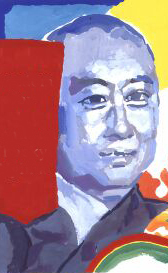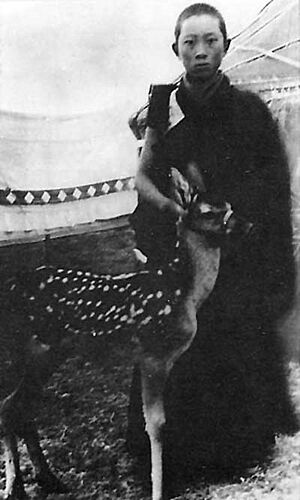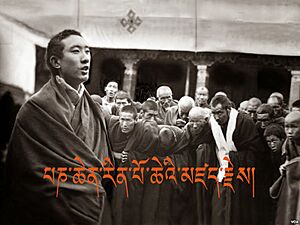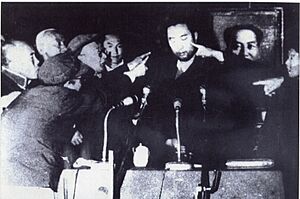Choekyi Gyaltsen, 10th Panchen Lama facts for kids
Quick facts for kids Lobsang Trinley Lhündrub Chökyi Gyaltsenཆོས་ཀྱི་རྒྱལ་མཚན |
|
|---|---|
| The 10th Panchen Lama | |

10th Panchen Lama by Claude-Max Lochu
|
|
| 10th Panchen Lama | |
| Reign | 3 June 1949 – 28 January 1989 |
| Predecessor | Thubten Choekyi Nyima |
| Successor | 11th Panchen Lama: Gedhun Choekyi Nyima (Recognized by the 14th Dalai Lama) Gyaincain Norbu (Chinese proxy selection) |
| Director of the Preparatory Committee for the Tibet Autonomous Region (acting) |
|
| In office | 1959 – 1964 |
| Predecessor | 14th Dalai Lama |
| Successor | Ngapoi Ngawang Jigme (acting) |
| 2nd, 5th, 6th, 7th Vice Chairman of the National People's Congress | |
| In office | 15 September 1954 – 18 April 1959 |
| In office | 10 September 1980 – 28 January 1989 |
| 2nd, 3rd, 5th Vice Chairman of the Chinese People's Political Consultative Conference | |
| In office | 15 September 1954 – 21 December 1964 |
| In office | February 1979 – 6 June 1983 |
| Born | Gönbo Cêdän 19 February 1938 Bido, Xunhua County, Qinghai, Republic of China, known as Amdo |
| Died | 28 January 1989 (aged 50) Shigatse, Tibet Autonomous Region, People's Republic of China, known as Ü-Tsang |
| Burial | Tashi Lhunpo Monastery, Shigatse |
| Spouse | Li Jie |
| Issue | Yabshi Pan Rinzinwangmo |
| Father | Gonpo Tseten |
| Mother | Sonam Drolma |
| Religion | Tibetan Buddhism |
| Official title: 10th Panchen Erdeni | |||||||||||||||
|---|---|---|---|---|---|---|---|---|---|---|---|---|---|---|---|
| Traditional Chinese | 第十世班禪額爾德尼 | ||||||||||||||
| Simplified Chinese | 第十世班禅额尔德尼 | ||||||||||||||
| Literal meaning | Number-10-lifetime + Pandita-Chenpo (Sanskrit-Tibetan Buddhist title, meaning "Great Scholar") + Erdeni (Manchu loanword from Mongolian, meaning "treasure") |
||||||||||||||
|
|||||||||||||||
| Dharma name: Lobsang Trinley Lhündrub Chökyi Gyaltsen | |||||||
|---|---|---|---|---|---|---|---|
| Chinese name | |||||||
| Traditional Chinese | 羅桑赤列倫珠確吉堅贊 | ||||||
| Simplified Chinese | 罗桑赤列伦珠确吉坚赞 | ||||||
| Literal meaning | 善慧事業運成法幢 | ||||||
|
|||||||
| Tibetan name | |||||||
| Tibetan | བློ་བཟང་ཕྲིན་ལས་ལྷུན་གྲུབ་ཆོས་ཀྱི་རྒྱལ་མཚན་་ | ||||||
|
|||||||
| Original name: Gönbo Cêdän | |||||||
|---|---|---|---|---|---|---|---|
| Chinese name | |||||||
| Traditional Chinese | 貢布慈丹 | ||||||
| Simplified Chinese | 贡布慈丹 | ||||||
|
|||||||
| Tibetan name | |||||||
| Tibetan | མགོན་པོ་ཚེ་བརྟན་ | ||||||
|
|||||||
Lobsang Trinley Lhündrub Chökyi Gyaltsen was the tenth Panchen Lama. He was born as Gönbo Cêdän on February 19, 1938. He passed away on January 28, 1989. In Tibetan Buddhism, the Panchen Lamas are seen as special spiritual leaders. They are believed to be living forms of the Buddha Amitabha. His official title was the 10th Panchen Erdeni. He was also often called Choekyi Gyaltsen.
Contents
Becoming the Panchen Lama
The line of Panchen Lamas started in the 1600s. This happened after the 5th Dalai Lama gave the title to a monk named Chokyi Gyeltsen. He was declared a special spiritual being. This monk became the first Panchen Lama. He was also the sixteenth head of the Tashilhunpo Monastery.
The 10th Panchen Lama was born as Gonpo Tseten. His birthplace was Bido, in a place called Amdo (now Qinghai). His father was also named Gonpo Tseten, and his mother was Sonam Drolma.
Finding the Next Panchen Lama
After the Ninth Panchen Lama died in 1937, people started looking for the next one. Two different boys were found as possible candidates. The government in Lhasa chose one boy from Xikang. But the Ninth Panchen Lama's close helpers chose Gonpo Tseten.
On June 3, 1949, the government of the Republic of China supported Gonpo Tseten. A few days later, on June 11, 1949, Gonpo Tseten was officially made the 10th Panchen Lama. He was 12 years old by Tibetan counting. This happened at the Kumbum Jampa Ling monastery in Amdo. He was given the name Lobsang Trinley Lhündrub Chökyi Gyaltsen.
Later, the 14th Dalai Lama also recognized him. This happened after they met in Lhasa.
Early Life and Role
The Panchen Lama supported China's claim over Tibet. He also supported China's plans for changes in Tibet. In 1951, he was invited to Beijing. This was when Tibetan leaders were signing an agreement with China. This agreement was called the 17-Point Agreement.
In September 1954, the Dalai Lama and the Panchen Lama traveled to Beijing. They attended a big meeting called the National People's Congress. There, they met important leaders like Mao Zedong. The Panchen Lama was chosen to be a member of a special committee. He also became a deputy chairman of the Chinese People's Political Consultative Conference.
In 1956, the Panchen Lama went on a religious trip to India with the Dalai Lama. When the Dalai Lama left Tibet for India in 1959, the Panchen Lama stayed. He publicly supported the Chinese government. The Chinese government then made him the head of the committee for the Tibet Autonomous Region.
Speaking Out and Challenges
In 1962, the Panchen Lama traveled around Tibet. He saw many problems and wrote a long report. This report was sent to Prime Minister Zhou Enlai. In it, he spoke out against some of the government's actions in Tibet. This report became known as the 70,000 Character Petition.
Many people believe this report was the most detailed criticism of China's policies in Tibet. At first, the government seemed to react positively. But later, Chairman Mao called the report "a poisoned arrow" against the ruling party.
For many years, this report was kept secret. Only top Chinese leaders knew about it. A copy of the report was found in 1996. In 1998, an English version was published. It was called A Poisoned Arrow: The Secret Report of the 10th Panchen Lama.
Imprisonment
In 1964, the Panchen Lama faced public criticism. He was removed from his important positions. He was called "an enemy of the Tibetan people." His personal writings were taken and used against him. He was then put in prison. He was only 26 years old at the time. His situation became even harder when the Cultural Revolution began.
He was released in October 1977. But he was kept under house arrest in Beijing until 1982. After his release, he was allowed to return to public life. He took on important roles again, like Vice Chairman of the National People's Congress.
Later Life and Family
In 1978, the Panchen Lama decided to marry and start a family. He met Li Jie, whose father was a general in the Chinese army. She was a medical student. At that time, the Panchen Lama did not have much money. He was also still facing some political difficulties.
However, important leaders in China saw the meaning of a marriage between a Tibetan leader and a Han Chinese woman. They helped arrange a big wedding for the couple in 1979. A year later, the Panchen Lama was given more important political jobs. By 1982, he was fully back in good standing with the government.
His Daughter
In 1983, the Panchen Lama and Li Jie had a daughter. Her name is Yabshi Pan Rinzinwangmo. She is sometimes called the "Princess of Tibet." She is important in Tibetan Buddhism and in the relationship between Tibet and China. This is because she is the only known child in the history of either the Panchen Lama or Dalai Lama spiritual lines.
Rinzinwangmo has not commented on her father's death. She has said that his early death was due to his poor health, weight gain, and lack of sleep. After his death, there was a disagreement over his money and belongings. This dispute was between his wife and daughter and the Tashilhunpo Monastery.
Return to Tibet and Final Years
The Panchen Lama made several trips to Tibet from Beijing starting in 1980. During these visits, he met with important Buddhist teachers. He also helped to support and bless religious centers.
In 1987, he started a business called the Tibet Gang-gyen Development Corporation. His idea was to help Tibetans take charge of their own future and modernization. This plan also included rebuilding important Buddhist sites that had been damaged.
In early 1989, the 10th Panchen Lama went back to Tibet. He went to rebury the bones of previous Panchen Lamas. Their graves at Tashilhunpo Monastery had been destroyed. He placed their remains in a new monument.
On January 23, 1989, the Panchen Lama gave a speech in Tibet. He said that while there had been progress, the cost of this progress was very high. He spoke against the harsh actions that had happened in Tibet. He also praised the economic changes happening in China during the 1980s.
Five days later, on January 28, the Panchen Lama died in Shigatse. He was 50 years old. The official reason for his death was a heart attack. However, some Tibetans had questions about his death.
Many ideas spread among Tibetans about how the Panchen Lama died. Some people, including the Dalai Lama, believed he might have been poisoned. This theory was supported by some of the things he said in his speech on January 23.
In 2011, a Chinese writer suggested that a high-ranking official was involved in the Panchen Lama's death. The Dalai Lama was invited to the Panchen Lama's funeral by the Buddhist Association of China. However, the Dalai Lama was not able to attend.
Images for kids






